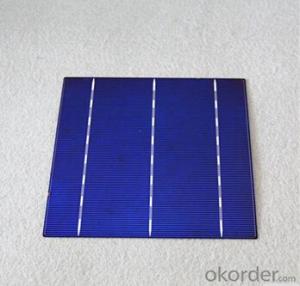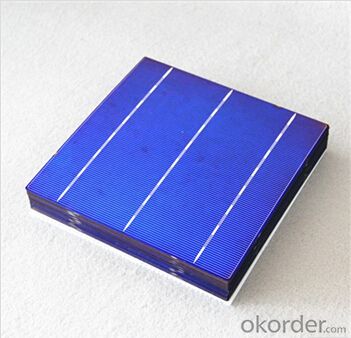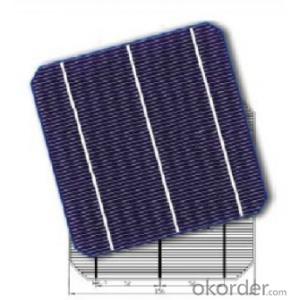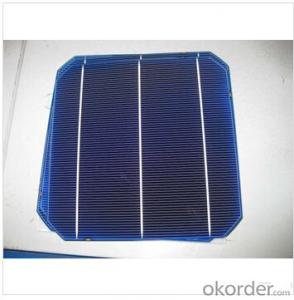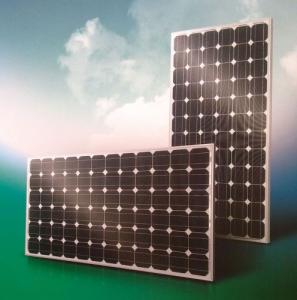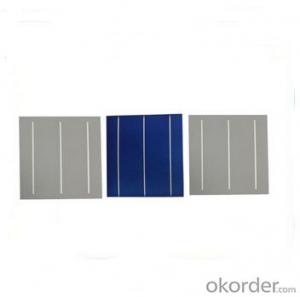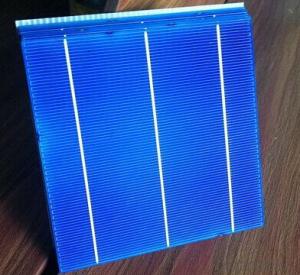Nanomaterials Solar Cells - Polycrystalline A Grade High Efficiency 3BB 156*156mm
- Loading Port:
- Shanghai
- Payment Terms:
- TT or LC
- Min Order Qty:
- 5000 pc
- Supply Capability:
- 8000000 pc/month
OKorder Service Pledge
OKorder Financial Service
You Might Also Like
Polycrystalline Silicon Solar Cells:
Solar cells is made by solar wafer, it has three categories of solar cell right now, monocrystalline polycrystalline and thin film,These cells are entirely based around the concept of ap-n junction, which is the critical part of solar module, it is the part that can convert the light energy into electricity, the thickness is from 180um to 200um, with even busbars to conduct electricity, textured cell can decrease diffuse reflection; they are often electrically connected and encapsulated as a module. Photovoltaic modules often have a sheet of glass on the front (sun up) side, allowing light to pass while protecting semiconductor wafers from abrasion and impact due to wind-driven debris, rain, hail, etc. Solar cells are also usually connected in series in modules, creating an additive voltage. Connecting cells in parallel will yield a higher current;With high quality and stable quality. Our Cells can greatly improve the performance of Solar Modules.
Features
1.High conversion efficiency resulting in superior power output performance.
2.Outstanding power output even in low light or high temperature conditions
3.Optimized design for ease of soldering and lamination
4.Long-term stability,reliability and performance
5.Output power tolerance of +/-3%
Specification:
Mechanical data and design |
Format - 156 mm × 156 mm ± 0.5 mm |
Thickness- - 200 μm ± 20 μm |
Front (-) - 1.4 mm bus bars (silver),blue anti-reflection coating (silicon nitride) |
Back (+) - 2 mm wide soldering pads (silver) back surface field (aluminium) |
Temperature Coefficient of Cells |
Voc. Temp .coef.%/K -0.364%/K |
Isc . Temp .coef.%/K +0.077%/K |
Pm. Temp. coef.%/K -0.368%/K |
Efficiency code | Efficiency(%) | Pmax(w) | Impp(A) | Vmpp(V) | Isc(A) | Voc(V) |
182 | ≥18.20 | 4.43 | 8.26 | 0.536 | 8.71 | 0.634 |
180 | 18.0-18.2 | 4.38 | 8.22 | 0.533 | 8.68 | 0.632 |
178 | 17.8-18.0 | 4.33 | 8.17 | 0.530 | 8.63 | 0.630 |
176 | 17.6-17.8 | 4.28 | 8.12 | 0.527 | 8.60 | 0.627 |
174 | 17.4-17.6 | 4.23 | 8.08 | 0.524 | 8.56 | 0.625 |
172 | 17.2-17.4 | 4.19 | 8.05 | 0.521 | 8.53 | 0.622 |
170 | 17.0-17.2 | 4.14 | 7.99 | 0.518 | 8.49 | 0.620 |
168 | 16.8-17.0 | 4.09 | 7.94 | 0.515 | 8.45 | 0.618 |
Intensity Dependence |
Intensity [W/m2] Isc× [mA] Voc× [mV] Pmpp |
1000 1.00 1.000 1.00 |
900 0.90 1.000 0.90 |
800 0.80 0.99 0.80 |
500 0.50 0.96 0.49 |
300 0.30 0.93 0.29 |
200 0.20 0.92 0.19 |
IV Curve

Solar Panel Images:
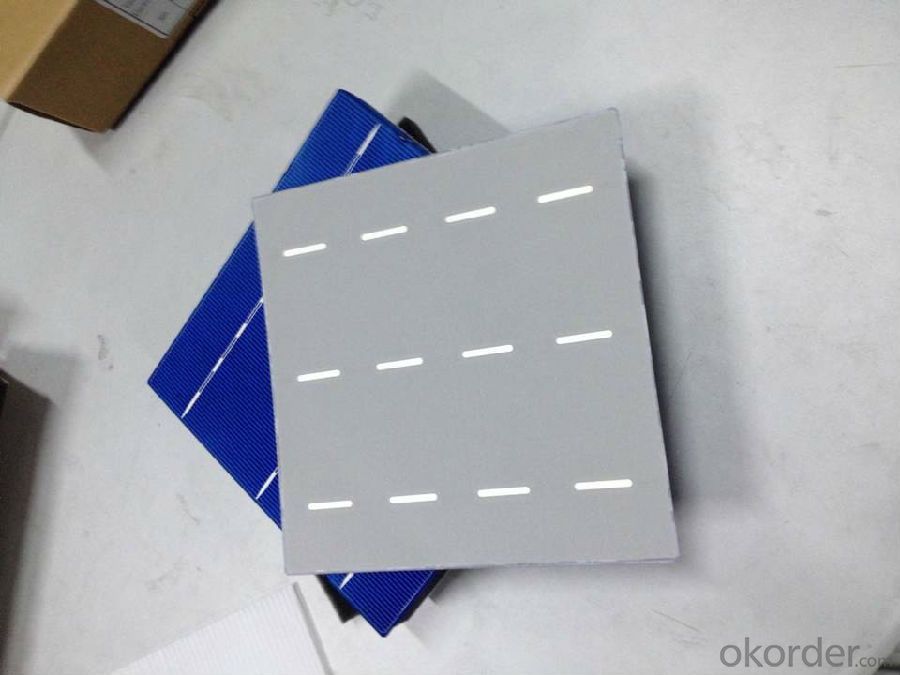
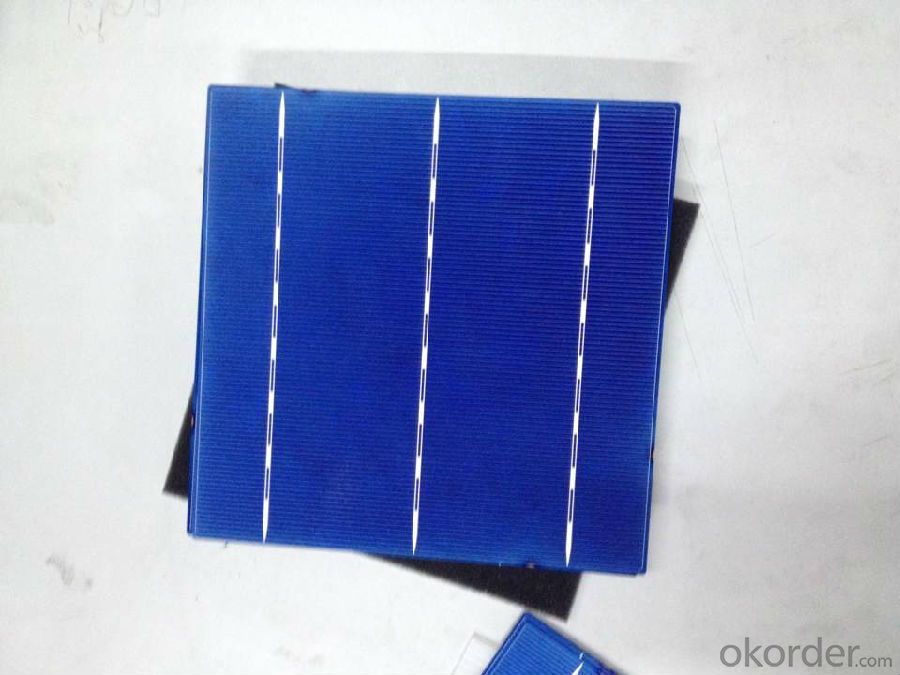


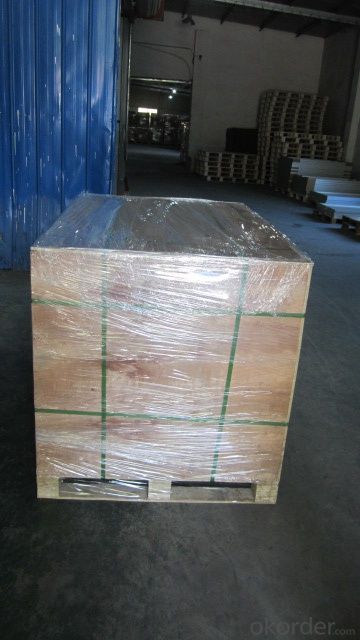
Packaging & Delivery of Polycrystalline Solar Cells
Carton Box Package and Deliver by air. It should be noticed that it should be avoid of water, sunshine and moist.
FAQ
We have organized several common questions for our clients,may help you sincerely:
①What price for each watt?
It depends on the efficiency of the solar cell, quantity, delivery date and payment terms.
②How long can we receive the product after purchase?
In the purchase of product within three working days, We will arrange the factory delivery as soon as possible. The pecific time of receiving is related to the state and position of customers.Commonly 7 to 10 working days can be served.
③Can you provide the peripheral products of the solar panels, such as the battery, controller, and inverter? If so, can you tell me how do they match each other?
Yes, we can, we have two companies for solar region, one is CNBM International, the other is CNBM engineering Co.
We can provide you not only the solar module but also the off grid solar system, we can also provide you service with on grid plant.
④What is your warranty of solar cell?
Our product can promise lower than 0.3% open box crack, we support claim after opening the box if it has crackm color difference or sth, the buyer should give pictures immediately, we can not accept the claim after the solar cell has assembled to solar panel.
• Timeliness of delivery
• ⑤How do you pack your products?
We have rich experience on how to pack the solar cell to make sure the safety on shipment, we could use wooden box or pallet as buyer's preference.
⑥ Can you do OEM for us?
Yes, we can.
Space solar power station in space means that solar energy will be converted into electrical energy, transmission by wireless energy transmission to the ground, or simply to reflect sunlight to the ground, on the ground power systems. In the present research the United States, Russia, Japan and other countries. Its development prospects are very promising.
Characteristics of Space Solar Cells
The greatest feature of this system is green. Collect solar energy in space, the impact on the global environment is small and completely dependent on the earth's resources.
To build solar power plants in the ground, due to the influence of atmospheric absorption and scattering effects of sunlight to the ground after strong attenuation to 1.0 kW / square meter; and if the establishment of the space solar power station, the light intensity of 1.353 kilowatts / square meters, and 99% time of day, and therefore has a high power generation efficiency.
While the power generation efficiency space solar power plant is far above the ground. Continuously receiving solar energy from space cannot be affected by the season, such as diurnal variation, receiving high energy density, it is 7-12 times the average light power of the ground; while stably transmit energy to the ground, basically from the atmosphere.
Space Station on the technical principles has been no problem. Solar panels widely used in satellites, but in recent years, the power generation efficiency of solar cells, the conversion efficiency of microwave technology has made great progress, has laid a good foundation for the development of the system. But to achieve the industry standard applications, the requirements for power generation will be high, at least megawatts, G watt magnitude; solar panels may use to calculate the square.
- Q: Can solar cells be used in recreational vehicles?
- Yes, solar cells can be used in recreational vehicles. Installing solar panels on RVs allows them to harness the power of the sun to generate electricity, which can be used to charge batteries and power appliances while on the road. This helps to reduce reliance on traditional power sources, making RVs more energy-efficient and environmentally friendly.
- Q: Can solar cells be used for powering space missions?
- Yes, solar cells can be used to power space missions. Solar cells, also known as photovoltaic cells, convert sunlight directly into electricity. They have been widely deployed in space missions to provide power for satellites, space probes, and even space stations like the International Space Station (ISS). Solar cells are a reliable and efficient source of renewable energy in space, as they can generate electricity even in the absence of an atmosphere.
- Q: Can solar cells be used for disaster relief efforts?
- Yes, solar cells can be used for disaster relief efforts. They provide a reliable and sustainable source of electricity, enabling the operation of essential equipment such as medical devices, communication systems, and water purification systems in areas affected by natural disasters. Solar cells can also be easily transported and quickly deployed in emergency situations, making them an ideal solution for providing power in remote or inaccessible locations.
- Q: Can solar cells be used in residential communities?
- Yes, solar cells can be used in residential communities. In fact, they are increasingly being adopted by homeowners and communities as a sustainable and cost-effective energy source. Solar panels installed on rooftops or in shared spaces can generate electricity by converting sunlight into usable energy, helping to reduce reliance on traditional power grids and lowering electricity bills.
- Q: Can solar cells be used in agriculture?
- Yes, solar cells can be used in agriculture. They can be used to power irrigation systems, lighting for greenhouses, and other agricultural equipment, helping to reduce reliance on traditional energy sources and promoting sustainable farming practices. Additionally, solar panels can be installed on agricultural buildings to generate electricity, providing a renewable energy source for farming operations.
- Q: Can solar cells be used in data centers?
- Yes, solar cells can be used in data centers. They can be installed on the roofs or surrounding areas of data centers to generate clean and renewable energy. This helps reduce the reliance on grid power and lowers the carbon footprint of the data center operations. However, the feasibility and effectiveness of using solar cells in a data center would depend on factors such as the available space, climate conditions, and energy requirements of the facility.
- Q: What is the impact of partial shading on solar cell performance?
- Partial shading can have a significant negative impact on solar cell performance. When a portion of the solar panel is shaded, the shaded cells produce less electricity, which can decrease the overall energy output of the system. This is due to the fact that shaded cells create a "bottleneck" effect, limiting the flow of current through the shaded area and affecting the entire series-connected cells. Additionally, partial shading can result in hotspots, leading to potential damage to the solar cells and reducing their overall lifespan. Therefore, it is crucial to design solar systems effectively and minimize any potential shading to maximize energy production.
- Q: Can solar cells be used to power electric vehicles?
- Yes, solar cells can be used to power electric vehicles. Solar cells can convert sunlight into electricity, which can then be used to charge the batteries of electric vehicles. This technology is being explored and implemented in various forms, such as solar panels integrated into the roof or body of the vehicle, to provide additional power and extend the range of electric vehicles.
- Q: How to manufacture solar cells?
- First of all, the silicon needs to be purified.
- Q: Do solar cells work at night or in low light conditions?
- No, solar cells do not work at night or in low light conditions as they rely on sunlight to generate electricity.
Send your message to us
Nanomaterials Solar Cells - Polycrystalline A Grade High Efficiency 3BB 156*156mm
- Loading Port:
- Shanghai
- Payment Terms:
- TT or LC
- Min Order Qty:
- 5000 pc
- Supply Capability:
- 8000000 pc/month
OKorder Service Pledge
OKorder Financial Service
Similar products
Hot products
Hot Searches
Related keywords

